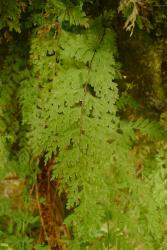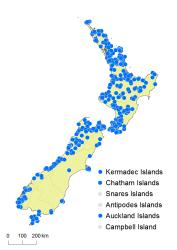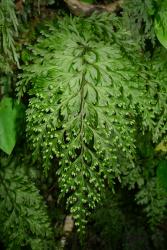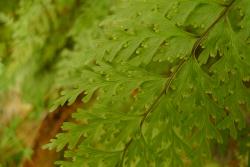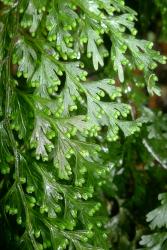- ≡ Trichomanes demissum G.Forst., Fl. Ins. Austr. 85 (1786)
- ≡ Sphaerocionium demissum (G.Forst.) C.Presl, Hymenophyllaceae 35 (1843)
- ≡ Mecodium demissum (G.Forst.) Copel., Philipp. J. Sci. 67: 24 (1938)
- = Hymenophyllum aucklandicum Bosch, Ned. Kruidk. Arch. 4: 393 (1859)
- ≡ Hymenophyllum australe var. aucklandicum (Bosch) C.Chr., Index Filic. 357 (1905)
- = Hymenophyllum erecto-alatum Colenso, Trans. & Proc. New Zealand Inst. 11: 431 (1879)
- = Hymenophyllum megalocarpum Colenso, Trans. & Proc. New Zealand Inst. 15: 308 (1883)
- ≡ Hymenophyllum demissum var. megalocarpum (Colenso) C.Chr., Index Filic. 364 (1905)
- = Hymenophyllum polychilum Colenso, Trans. & Proc. New Zealand Inst. 24: 395 (1892)
- ≡ Hymenophyllum demissum var. polychilum (Colenso) Domin, Biblioth. Bot. 20(85): 24 (1913)
Epiphytic, terrestrial or rupestral ferns. Rhizomes long-creeping, 0.5–1 mm diameter, glabrous or with a few red-brown hairs at bases of stipes up to 1 mm long. Fronds 75–450 mm long. Stipes 25–190 mm long, brown or red-brown throughout, not winged, glabrous or bearing a few scattered hairs. Laminae 3–4-pinnatifid or rarely 5-pinnatifid, elliptic or ovate or narrowly ovate, 45–270 mm long, 22–160 mm wide, pale green, membranous, glabrous or with very short scattered hairs on costae. Rachises narrowly winged throughout, reddish brown, glabrous or with a few scattered hairs; rachis wings planate. Primary pinnae in 7–20 pairs, overlapping, winged throughout, narrowly ovate to ovate, adnate; distal portion of primary pinnae straight or incurved acroscopically; the longest primary pinnae between middle and base, 18–85 mm long, 10–45 mm wide. Secondary pinnae arising both acroscopically and basiscopically, scarcely overlapping, winged throughout, elliptic to ovate, adnate; the longest secondary pinnae 6–30 mm long, 3–14 mm wide. Ultimate lamina segments oblong, up to 5 mm long, 0.5–1.5 mm wide; apices acute or obtuse; margins entire, with a distinct thickened border; distal segments on primary pinnae divergent or slightly curved towards frond apex. Sori borne on short acroscopic and basiscopic segments throughout pinnae, usually paired or rarely solitary, many on each primary pinna, adnate; indusia bivalvate; indusial flaps ovate or elliptic, 0.75–1.5 mm long, apices acute or obtuse, margins entire or notched; receptacles included within indusial flaps.
Hymenophyllum demissum is a medium to large filmy fern and the most common of all New Zealand filmy ferns. It is also the hardest to characterise, having few distinctive features, but can generally be recognised by its large, glabrous fronds with entire margins which are thickened to form a distinct border. The rachis is winged throughout but the stipe has no wing. The sori are often rather narrow and borne in pairs. The frond rarely curls up, even in dry weather, and the plant is often sterile over large areas.
Some plants on the Kermadec Islands are distinctly smaller than those on the main islands, having fronds just 55 mm long, stipes 22 mm long, laminae 35 mm long and 18 mm wide, and the primary pinnae 13 mm long and 7 mm wide.
North Island: Northland, Auckland, Volcanic Plateau, Gisborne, Taranaki, Southern North Island.
South Island: Western Nelson, Sounds-Nelson, Marlborough, Westland, Canterbury, Otago, Southland, Fiordland.
Kermadec Islands, Chatham Islands, Stewart Island, Auckland Islands.
Altitudinal range: 10–1170 m.
Hymenophyllum demissum occurs in lowland and montane areas throughout the North Island, extending from near sea level to 1070 m at Erua in the central North Island and on Maungapōhatu in the Urewera Range, and up to 1170 m on Mt Taranaki. In the South Island it is largely confined to western districts, with only scattered populations in the east from coastal Marlborough to Southland. It grows from near sea level to over 900 m in north-west Nelson and inland Marlborough. In the Auckland Islands, it is known from a single collection on Adams Island (CHR 134141).
Hymenophyllum demissum is the most common of all filmy ferns, growing in kauri, podocarp, beech and broadleaved forest and in tall kānuka scrub and swamp forest, most frequently on the ground, or on rocks, banks and fallen trunks and stumps, but also as an epiphyte. It has been recorded on the trunks of Cyathea dealbata, C. kermadecensis, C. smithii, Dicksonia squarrosa, Agathis australis, Beilschmiedia tawa, Dacrydium cupressinum, Elaeocarpus dentatus, Fuscospora truncata, Lophozonia menziesii, Metrosideros excelsa, Prumnopitys taxifolia and Rhopalostylis sapida.
Hymenophyllum erecto-alatum was described by Colenso (1879) from collections he made in dry forests near Forty-mile Bush, Norsewood in 1876 and 1878. There are two sheets at WELT and another at AK, all labelled "Norsewood". WELT P003007 and AK 119 are annotated "type of H. erecto-alatum Col." in Cheeseman’s hand-writing, whilst WELT P003286 has a label in Zotov’s writing copied from WELT P003007. Allan (1961, p. 28) cited a Colenso collection at WELT as the type but did not distinguish between the two sheets held there. However, Zotov’s label on WELT P003286 indicates that it is a copy of Cheeseman’s label on WELT P003007, and also that the material is part of the same specimen. It seems that Zotov segregated specimens from some of Colenso’s collections and re-labelled them (Brownsey 1979). In this case, Colenso’s material is now mounted on two sheets (with different registration numbers) but is part of the same specimen (Art. 8.3). Allan’s statement "Type: W, Colenso" can therefore be taken as a lectotypification and relates to these two sheets (WELT P003007 and P003286).
No type material of H. aucklandium has been located, and its inclusion in the synonymy of H. demissum relies on the opinion of Capeland (1937, p. 160) who said that he was unable to distinguish it from a small H. demissum (see Brownsey & Perrie 2016).



